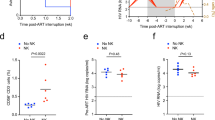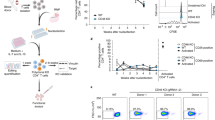Abstract
To date, a selective advantage of cells expressing anti-HIV ribozymes has not been shown. This study was undertaken to determine whether such a selective advantage can be demonstrated in vitro. A retroviral vector coding for a hairpin ribozyme targeting the HIV 5′LTR and for the low affinity nerve growth factor receptor (LNGF-RΔ) was designed. Since we demonstrated by RT-PCR that the amount of ribozyme transcripts was highly correlated with the level of surface LNGF-RΔ expression, the vector was utilized to assess ribozyme expression by flow cytometry. Transduced Hut78 and primary CD4+ T cells were purified and subsequently mixed with unmodified cells. After HIV challenge the percentage of ribozyme expressing cells in the cell mixture was monitored by flow cytometry. Twenty-one days after HIV infection the proportion of ribozyme expressing CD4+ T cells was 2.6 times higher in comparison to cells with the control vector. CD4+ T cells with a strong ribozyme expression conferred a 7.4-fold selective advantage at day 21 and a 11.7-fold at day 28. For Hut78 cells a selective advantage was detected exclusively for strongly ribozyme expressing cells. As a mechanism underlying the selective advantage an inhibition of HIV induced apoptosis was shown. These results demonstrate that anti-HIV ribozymes are able to confer a selective survival advantage and indicate that the protective effect is dependent on the amount of ribozyme expression.
This is a preview of subscription content, access via your institution
Access options
Subscribe to this journal
Receive 12 print issues and online access
$259.00 per year
only $21.58 per issue
Buy this article
- Purchase on Springer Link
- Instant access to full article PDF
Prices may be subject to local taxes which are calculated during checkout






Similar content being viewed by others
References
Sarver N et al. Ribozymes as potential anti-HIV-1 therapeutic agents Science 1990 247: 1222–1225
Ojwang JO et al. Inhibition of human immunodeficiency virus type 1 expression by a hairpin ribozyme Proc Natl Acad Sci USA 1992 89: 10802–10806
Rossi JJ, Sarver N . RNA enzymes (ribozymes) as antiviral therapeutic agents Trends Biotechnol 1990 8: 179–183
Gervaix A et al. Gene therapy targeting peripheral blood CD34+ hematopoietic stem cells of HIV-infected individuals Hum Gene Ther 1997 8: 2229–2238
Li X et al. Gene therapy targeting cord blood-derived CD34+ cells from HIV-exposed infants: preclinical studies Gene Therapy 1998 5: 233–239
Rossi JJ . Ribozymes Curr Opin Biotechnol 1992 3: 3–7
Yu M et al. In vitro and in vivo characterization of a second functional hairpin ribozyme against HIV-1 Virology 1995 206: 381–386
Wang L et al. Preclinical characterization of an anti-tat ribozyme for therapeutic application Hum Gene Ther 1998 9: 1283–1291
Zhou C et al. Inhibition of HIV-1 in human T-lymphocytes by retrovirally transduced anti-tat and rev hammerhead ribozymes Gene 1994 149: 33–39
Yamada O et al. Intracellular immunization of human T cells with a hairpin ribozyme against human immunodeficiency virus type 1 Gene Therapy 1994 1: 38–45
Wong-Staal F, Poeschla EM, Looney DJ . A controlled, phase 1 clinical trial to evaluate the safety and effects in HIV-1 infected humans of autologous lymphocytes transduced with a ribozyme that cleaves HIV-1 RNA Hum Gene Ther 1998 9: 2407–2425
Perelson AS et al. HIV-1 dynamics in vivo: virion clearance rate, infected cell life-span, and viral generation time Science 1996 271: 1582–1586
Rudoll T et al. High-efficiency retroviral vector mediated gene transfer into human peripheral blood CD4+ T lymphocytes Gene Therapy 1996 3: 695–705
Yamada O et al. Activity and cleavage site specificity of an anti-HIV-1 hairpin ribozyme in human T cells Virology 1994 205: 121–126
Ramezani A, Ding SF, Joshi S . Inhibition of HIV-1 replication by retroviral vectors expressing monomeric and multimeric hammerhead ribozymes Gene Therapy 1997 4: 861–867
Larsson S et al. A novel ribozyme target site located in the HIV-1 nef open reading frame Virology 1996 219: 161–169
Lo KM et al. Inhibition of replication of HIV-1 by retroviral vectors expressing tat-antisense and anti-tat ribozyme RNA Virology 1992 190: 176–183
Zhou C, Bahner I, Rossi JJ, Kohn DB . Expression of hammerhead ribozymes by retroviral vectors to inhibit HIV-1 replication: comparison of RNA levels and viral inhibition Antisense Nucleic Acid Drug Dev 1996 6: 17–24
Ramezani A, Joshi S . Comparative analysis of five highly conserved target sites within the HIV-1 RNA for their susceptibility to hammerhead ribozyme-mediated cleavage in vitro and in vivo Antisense Nucleic Acid Drug Dev 1996 6: 229–235
Pear WS, Nolan GP, Scott ML, Baltimore D . Production of high-titer helper-free retroviruses by transient transfection Proc Natl Acad Sci USA 1993 90: 8392–8396
Onodera M et al. Development of improved adenosine deaminase retroviral vectors J Virol 1998 72: 1769–1774
Chomczynski P, Sacchi N . Single step method of RNA isolation by acid guanidinium thiocyanate-phenol-chloroform extraction Anal Biochem 1987 162: 156–159
Hart H et al. A comparison of polymerase chain reaction and an infectivity assay for human immunodeficiency virus type 1 titration during virus inactivation of blood components Transfusion 1993 33: 838–841
Schmid I, Uittenbogaart CH, Keld B, Giorgi JV . A rapid method for measuring apoptosis and dual-color immunofluorescence by single laser flow cytometry J Immunol Meth 1994 170: 145–157
Acknowledgements
This work was supported by the Bundesministerium für Forschung und Technologie Grant-No. 01KI9406 and the estate of Marie Christine Held and Erika Hecker.
Author information
Authors and Affiliations
Rights and permissions
About this article
Cite this article
Klebba, C., Ottmann, O., Scherr, M. et al. Retrovirally expressed anti-HIV ribozymes confer a selective survival advantage on CD4+ T cells in vitro. Gene Ther 7, 408–416 (2000). https://doi.org/10.1038/sj.gt.3301094
Received:
Accepted:
Published:
Issue Date:
DOI: https://doi.org/10.1038/sj.gt.3301094



